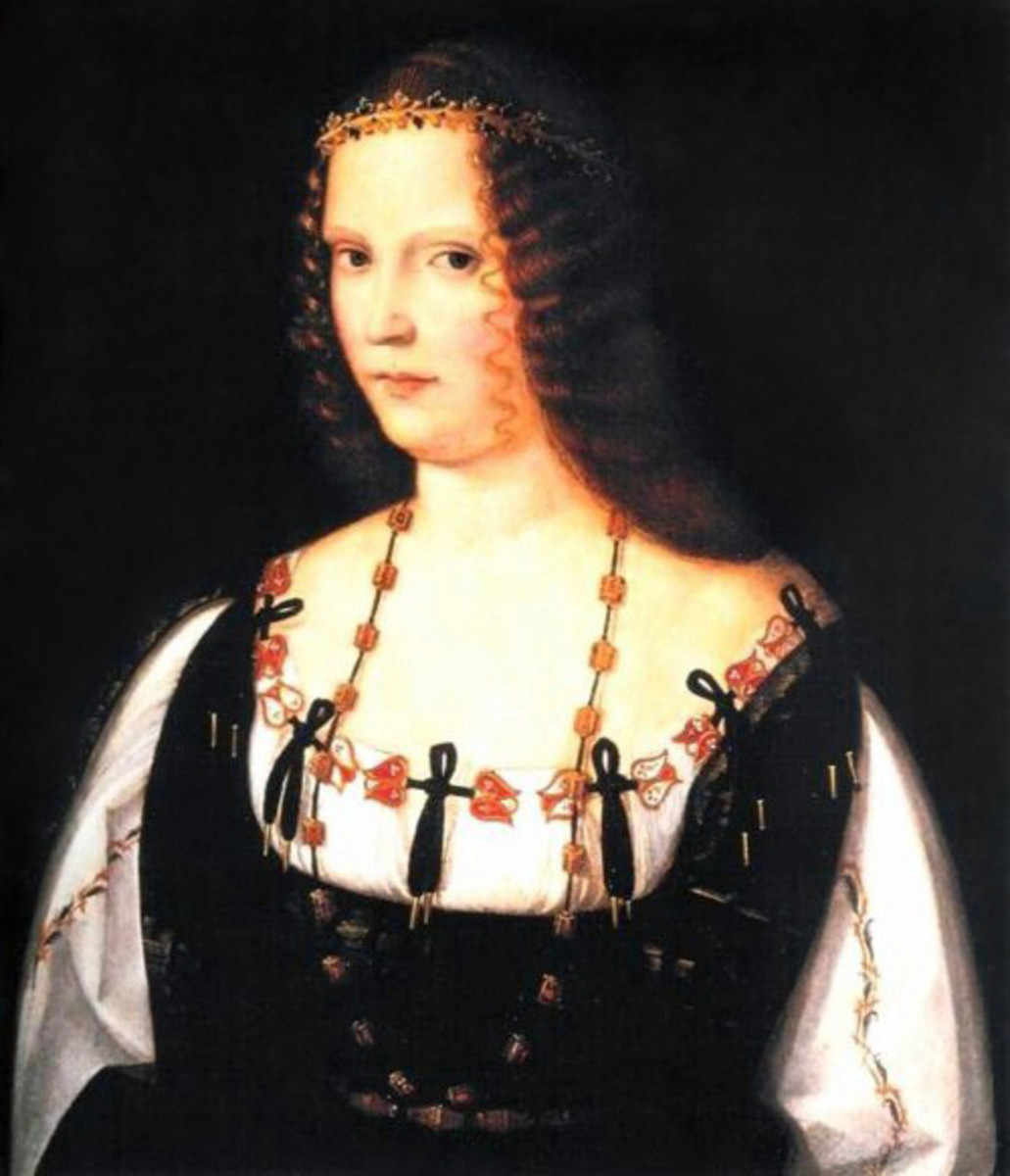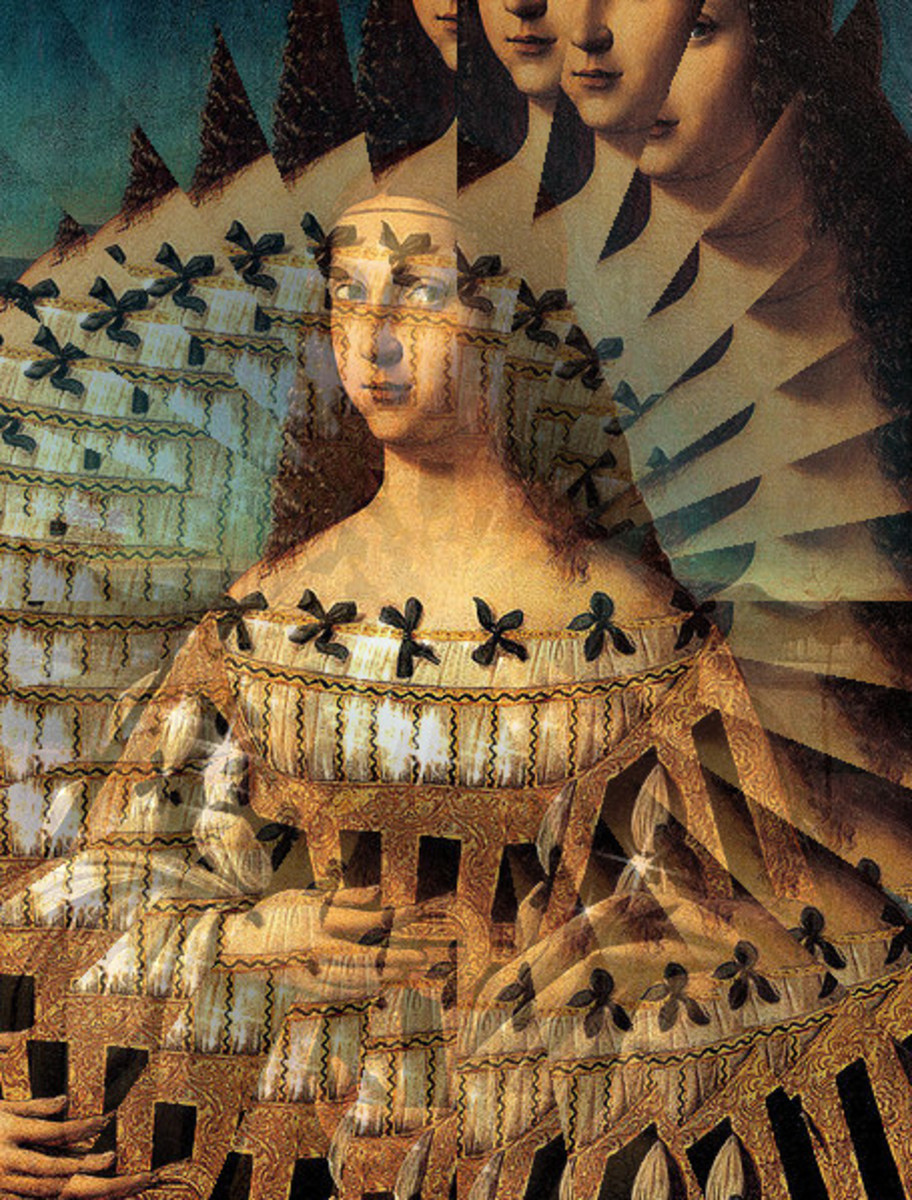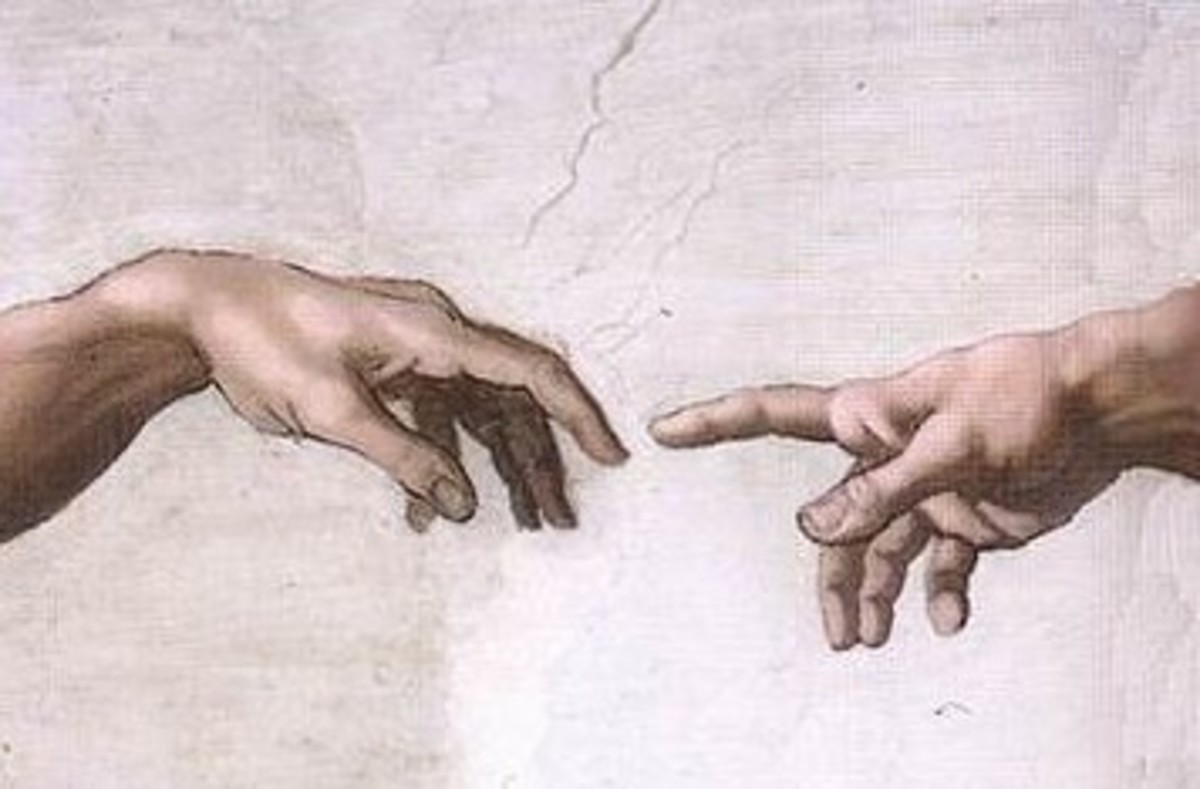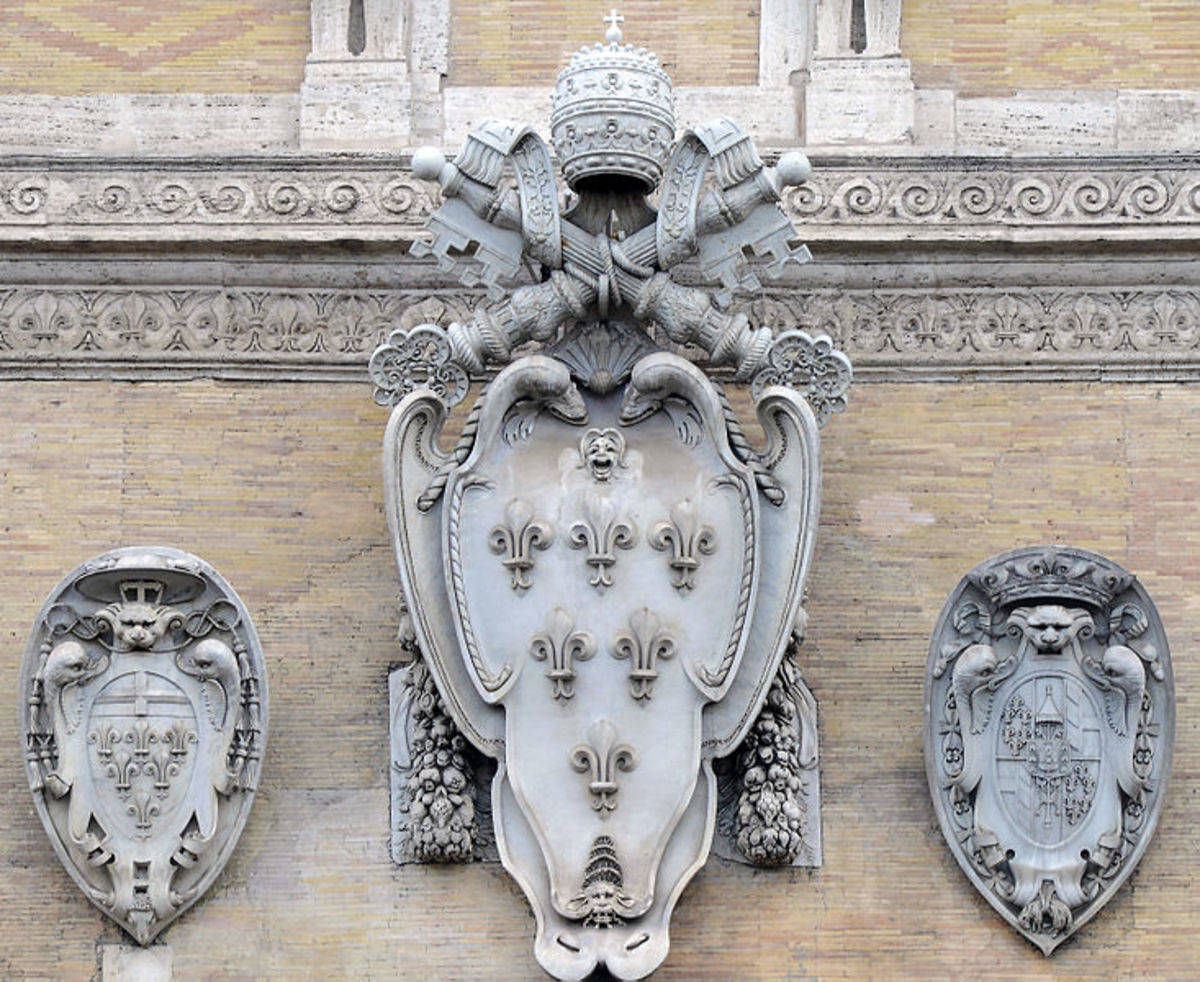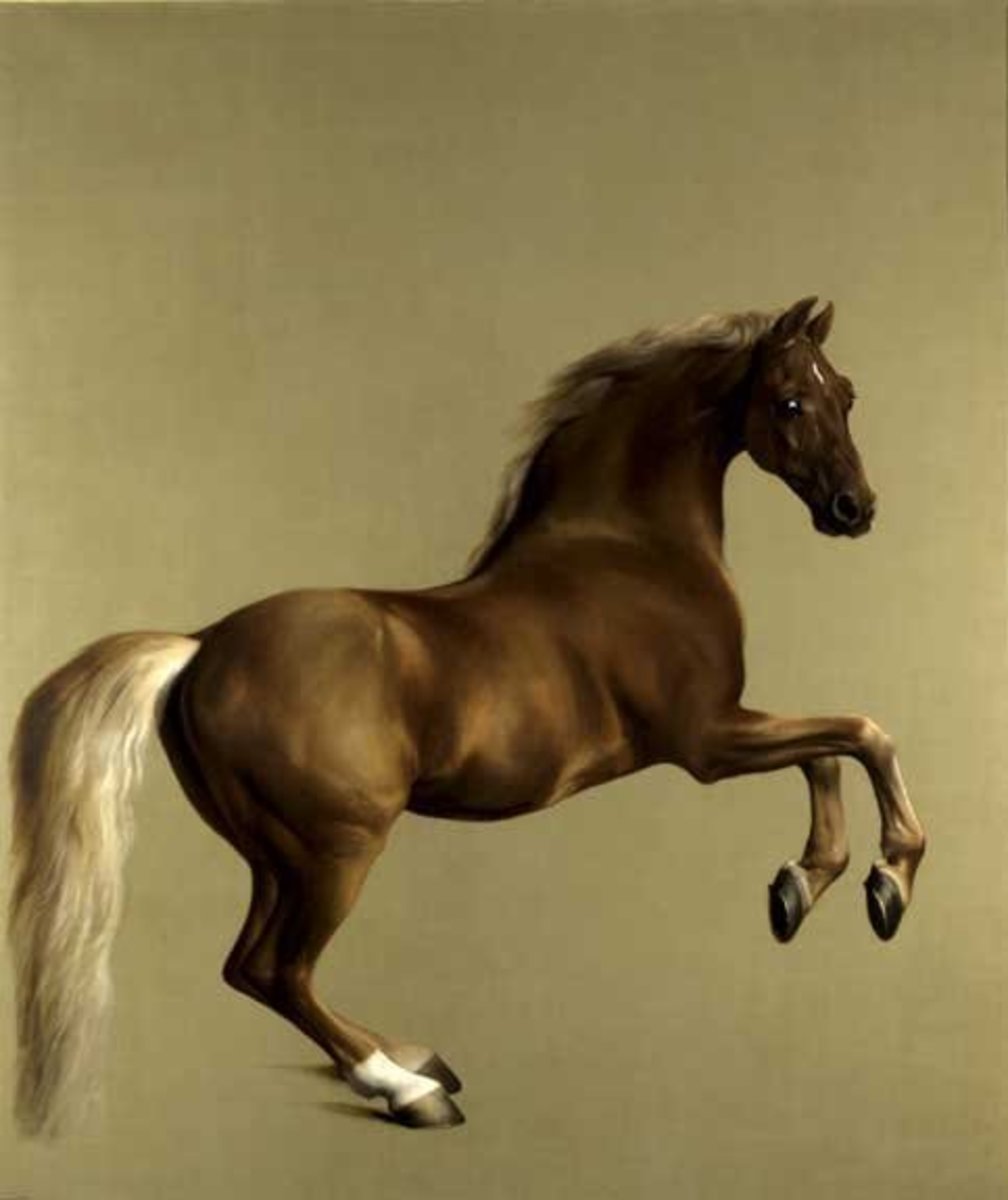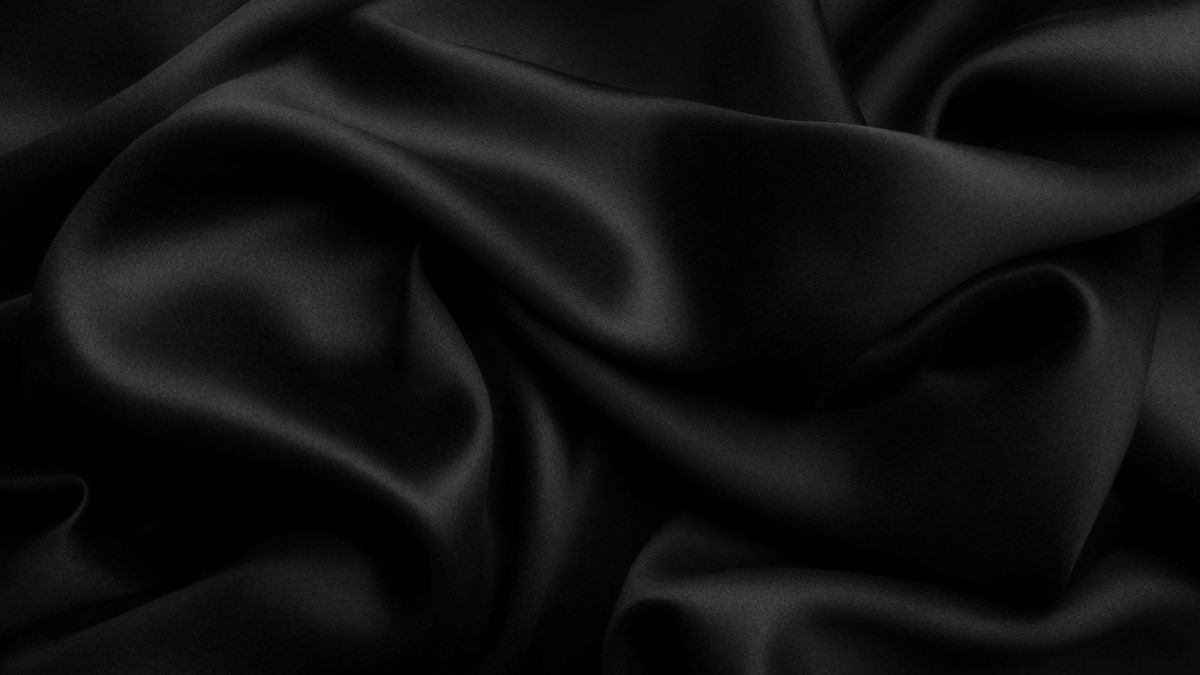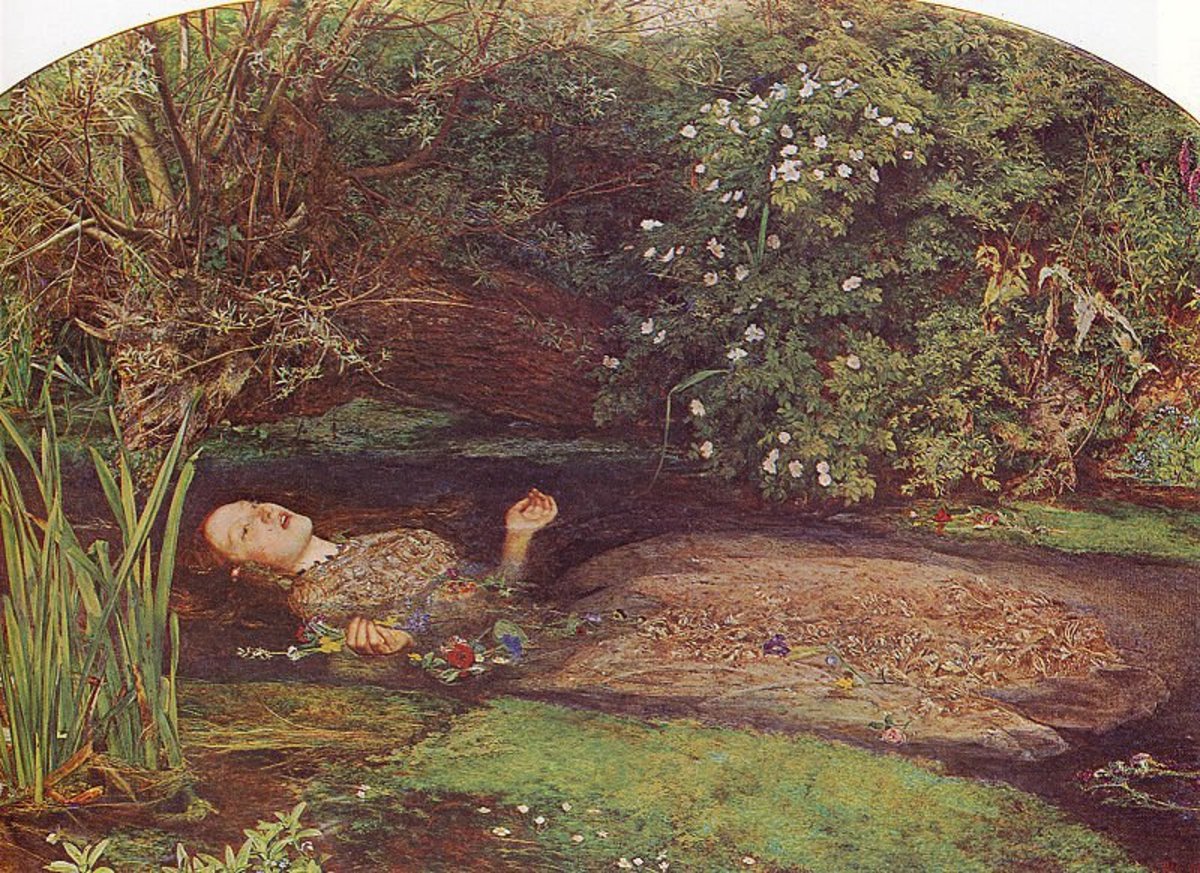Dosso Dossi, Painter of Fables at the Court of Ferrara
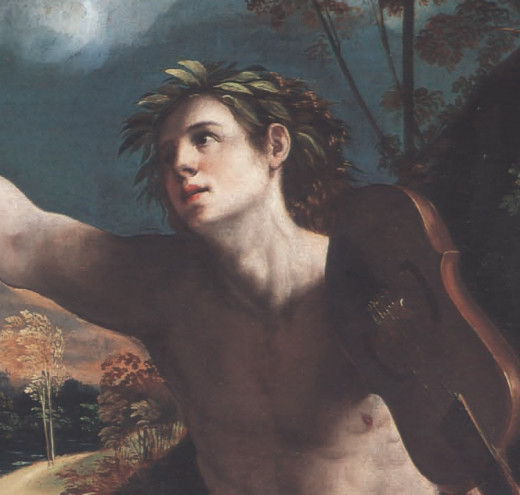
Court Painter in Ferrara
The figure of Giovanni Luteri, known as Dosso Dossi (San Giovanni del Dosso, a. 1486 - Ferrara 1542) can not be separated from the special environment where he lived and worked: the court of Ferrara ruled by the duke Alfonso d’Este (1476 – 1534). The duke is reported to be of abrupt character, unaware to please his subjects, mostly interested in manual activities. He was a skilled craftsman, expert in working with metals and ceramics, but did never neglect the arts and the artists. In the perfect style of a Renaissance Maecenas, Alfonso d’Este loved to be surrounded by artists and poets. Ludovico Ariosto, maybe the most emblematic poet of our Renaissance, was on the payroll of the duke. He wrote his best known poem (Orlando Furioso) at the court of Ferrara and devoted it to the illustrious Este family. The evenings at the court were enlivened by games, music and readings of poetry. The sister of the duke Alfonso, Isabella d’Este, duchess of Mantua, was a fine humanist. The second wife of the duke was Lucrezia Borgia, natural daughter of the pope Alexander VI. The woman – maybe portrayed in a painting of Dosso – is another symbolic figure of the Italian Renaissance, known for her intrigues and supposed wickedness. She was initially received with distrust at the court, but was subsequently well accepted and contributed to enrich the circle of humanists who frequented it.
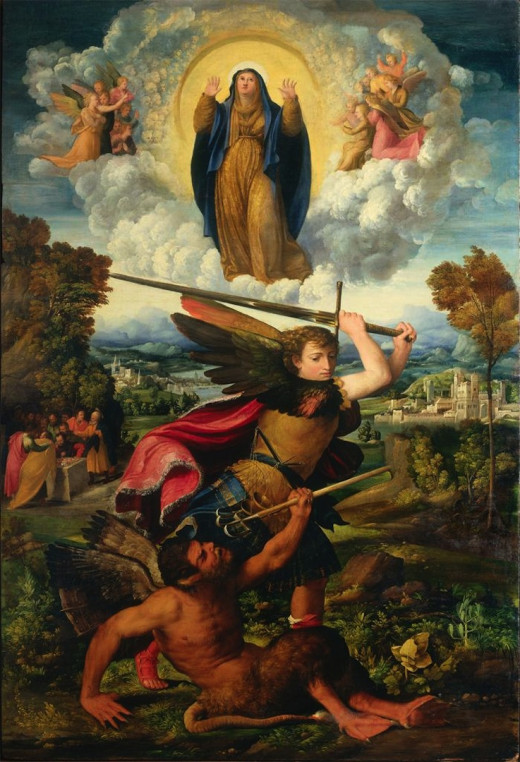
A Rebus As Signature
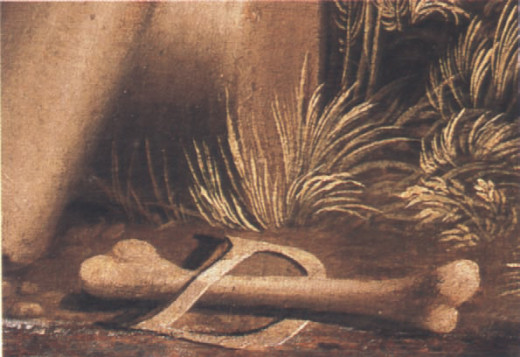
In the above picture, Dosso has used a simple rebus to form his signature: D + OSSO (the Italian word for bone) = DOSSO
The Biography by Vasari
Dosso officially arrived at the court of Ferrara in 1514, as a court painter and he stayed there, living in the castle, until his death in 1542. Very little is known of his life before the arrival in Ferrara. The surname Dosso probably derives from a small property of the father in the today San Giovanni del Dosso. He trained at contact with the Venetian school, as his early works show a clear tribute to the Venetian tradition, especially Giorgione. In his short biography, Vasari tells that Dosso excelled in the art of landscape and that he was very appreciated by the duke Alfonso d’Este for his artistic qualities and also because he was an affable and pleasant man, i.e. the kind of men that the Duke liked to have around himself. Vasari also says that Dosso used to work with his brother Battista, less talented, and that the two were constantly quarrelling. However, Vasari’s biography is affected by a good deal of envy, for at least two reasons. First, Dosso had been mentioned by Ludovico Ariosto in the poem Orlando Furioso and placed near the greatest painters of the time, included the “divine Michelangelo”, honour that he had not received and that he thought Dosso did not merit. Second, Dosso and his brother Battista were preferred to him for the decoration of the Villa Imperiale in Pesaro (a. 1530). Vasari revenges. He writes that the frescoes of the two brothers in the chamber that had been assigned to them (Sala delle Cariatidi) had been judged ridiculous and destroyed by Genga, the superintendent to the works. A third more general reason may be that Dosso did not belong to his beloved Tuscany school, upon which the sort of the renaissance of the Italian art was mostly based.
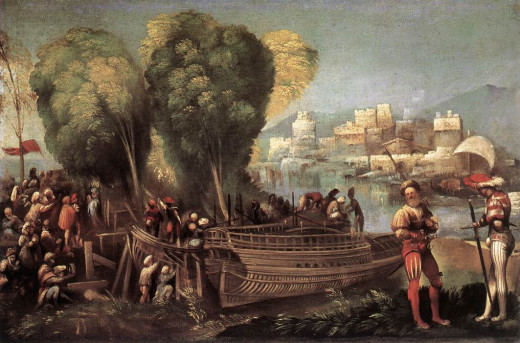
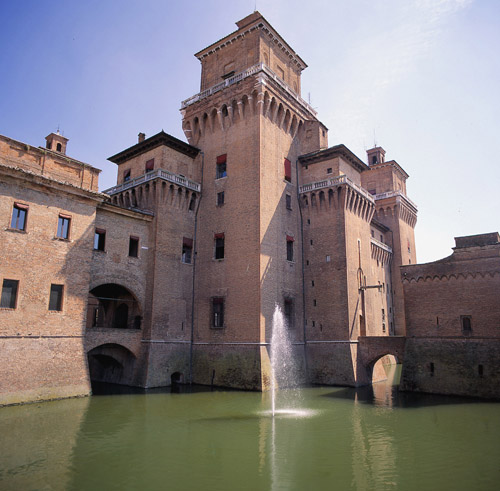
Works at the Court
Despite many of his works have been lost, Dosso and his assistants were constantly employed at the court of Ferrara for a wide range of purposes, related to the decoration of the duke’s dwellings and to the promotion of the Duchy’s image. Dosso managed all the aspects of the “visual communication”, including the design of banners, tapestries and flags. One of the most prestigious projects he supervised was the decoration of the private studio of Alfonso (the famous Camerino), which included three great works by Titian (Bacchus and Ariadne, The Worship of Venus and The Bacchanal of the Andrians) and one by Bellini (The Feast of the Gods), and that, in the duke’s mind, should have included also works by Raphael and Michelangelo. A Bacchanal and a series of scenes from the Virgil’s Aeneid, by Dosso himself, completed the project. Dosso also worked intensively for the decoration of the Delizie, the country side residences used by the Este family for the hours of relaxation and pleasure. We know that Alfonso called Dosso for the decoration of the Belvedere, the country house he mostly had in the hearth. Despite there are no remains of the villa, we can easily imagine that Alfonso found the imaginary and wild landscapes of Dosso perfectly harmonized with the atmosphere of the Delizie. In fact, Dosso had elaborated the art of Venetian masters, such as Giorgione and Titian, and that of the Roman school, represented by Michelangelo and Raphael, infusing in his works a touch of whimsy and poetry that represent the pictorial counterpart of the Ariosto’s poems. Paintings such as Circe and her Lovers (a. 1512), Three Ages of Man (a. 1514), Melissa (a. 1515), Jupiter Mercury and Virtue (a. 1524) well illustrate Dosso’s attitude, especially loved by the duke Alfoso, to represent a lush nature inserted in a magic and fantastic context.
The Geography of Dosso's Works
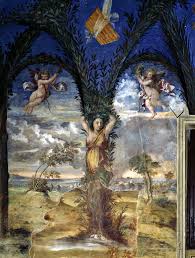
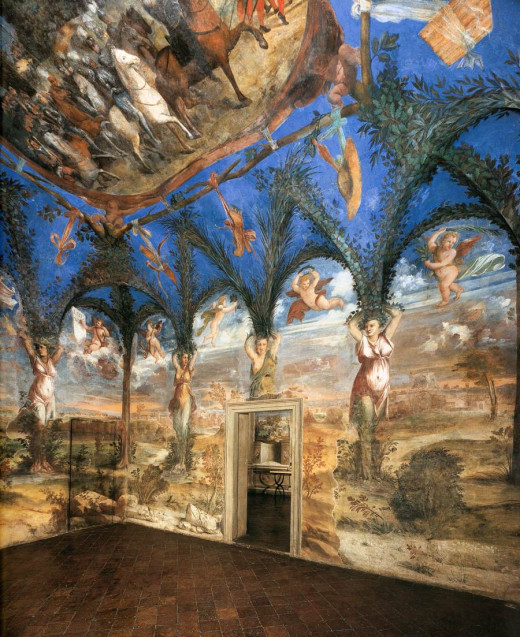
Works Outside the Court
On two occasions, around 1530, Dosso and his brother Battista were authorized to work in important projects outside the Duchy of Ferrara. The first one is the decoration of the Villa Imperiale, nearby Pesaro. The Villa was a property of the duke of Urbino, Francesco Maria I della Rovere. He and his wife, Eleonora Gonzaga, daughter of the duke of Mantua, charged the painter Gerolamo Genga to form a “team” of artists and to superintend to the decoration of several rooms of the villa. Dosso was enrolled, with his brother, as a specialist of landscape. He was the only artist coming from the North, all the other being mainly from Central Italy (Bronzino among them). Giorgio Vasari reports this event with a subtle malice, maybe induced by the fact the he had not been included in the team. The two (Dosso and Battista), says Vasari, had come with the intention to show the world how bright was their art and had the honour to fresco their own room (the Sala delle Cariatidi), while the others had to share the work. However, continues Vasari, as it sometimes happens when someone wants to do his best, they obtained their worst result ever, and it was found so ridiculous by the duke, that it was removed. But this is not true really, because the main frescoes of Dosso are still there and display the lush nature that had somewhat perplexed the orthodox team of Genga.
The other project outside Ferrara was the decoration of the Palazzo del Buonconsiglio in Trent, the residence of the cardinal Bernardo Cles, an affirmed diplomat of the Church. The cardinal commissioned a little group of artists led by Dosso the frescoes in the interior of the Palace. The whole work, involving 19 different areas, was conducted by Dosso in a few months between 1531 and 1532. The cardinal was completely satisfied with the result, although Dosso’s frescoes here lack the vigour that we find in the Villa Imperiale and in the paintings of the period 1510 – 1530.
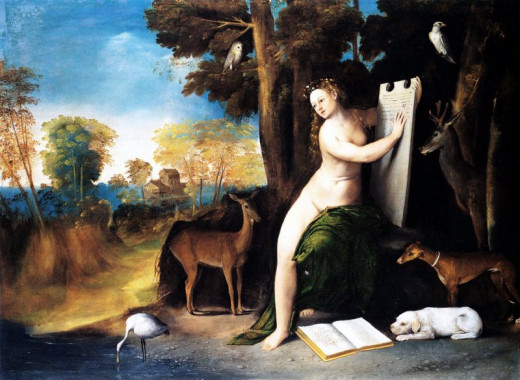
A Fantastic Natural World
Circe and Her Lovers in a Landscape
The painting is included among the Dosso’s earlier works and is dated around 1512. It was probably painted for the duke of Mantua, Francesco II Gonzaga, since the description of a similar canvas appears in the inventories of the King Charles I, who had acquired the whole collection of the Gonzaga. The canvas shows an evident influence of the Venetian Masters and Dosso’s love for the natural elements inserted in the landscape. The sorceress Circe lived in an island, became lover of the men who landed there, then transformed them into animals. The episode is told in the Homer’s Odyssey. Here Circe appears as the sensual queen of the natural world, with her transformed lovers coming docile to her. A similar figure (Alcina) is also described in the Orlando Furioso by Ariosto.
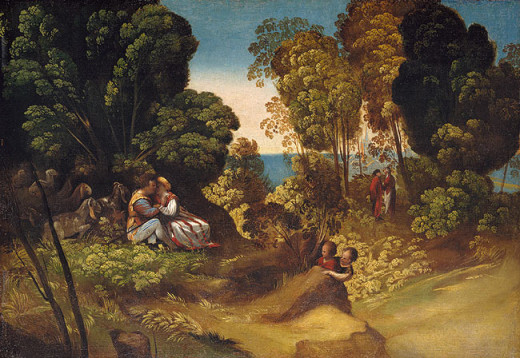
The Three Ages of Man
This painting is commonly considered slightly later than Titian’s homonymous work and is hence dated around 1514-1515. With respect to the painting by Titian, Dosso places the landscape, a lush wood with a glimpse of the sea, at the centre of the representation. The human figures, in court dresses, are merged in the landscape and appear to form a casual scene, where the two children spy the lovers and the two old men are talking between them on the background. Nevertheless, they quite clearly refer to the different ages of man, from childhood to oldness.
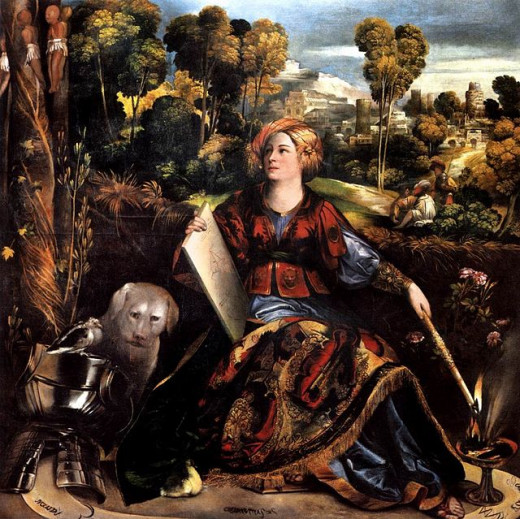
Melissa
The painting is considered an early work and is commonly dated before 1520. It shows the Dosso’s superb technique, derived from the study of Venetian artists, in rendering the chromaticism of the woman’s rich costume. The landscape surrounds the woman and nearly seems to emanate from her. The figure was first thought to be the sorceress Circe and then identified as the enchantress Melissa in the Orlando Furioso. The dog, the birds, the armour in the left corner and the strange little figures on the tree can be explained with the activity of Melissa. She rescued the warriors, transformed into animals or plants, from the enchantment of the naughty sorceress Alcina, and gave them back their weapons.
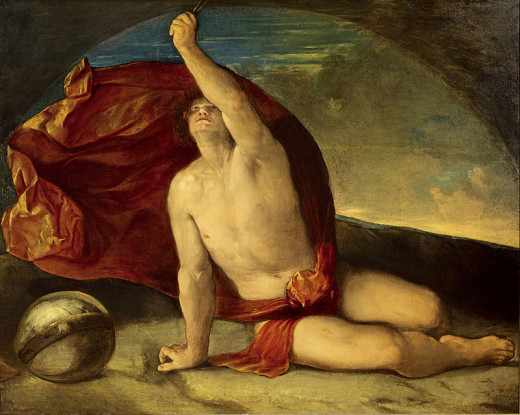
Naked Men from Michelangelo
The influence of the mighty male nudes by Michelangelo, especially the figures of the Ignudi in the Sistine Chapel ceiling, is explicit in the series of the Learned Men, four paintings datable around 1520-1522, probably depicted for a residence of Alfonso. However, the influence of Michelangelo’s figures is evident also in some subsequent works, where Dosso represents the naked bodies of the gods Mercury and Apollo.
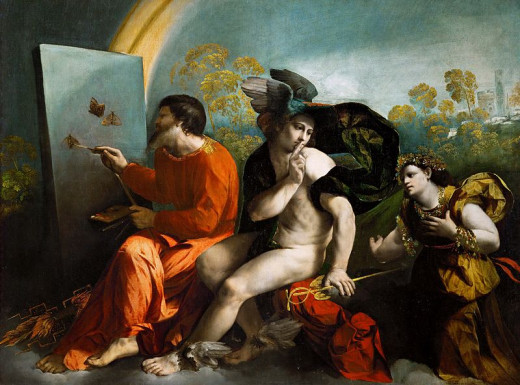
Jupiter, Mercury and Virtue
This is one of the most famous and discussed works by Dosso. Jupiter is represented in an ecstatic posture, while he is painting butterflies on a canvas and seems to be forgetful of any other matter. Mercury assists his work and intimates the silence to the Virtue, that is about to bother him. The origin of the episode has been individuated in a dialogue by Leon Battista Alberti (a. 1430), attributed to the Greek writer Lucian in those days. The sense of the painting has been debated for long time, but its ultimate meaning may reside in the absolute experience of the art: even the discourses of the virtue can not interfere with it.
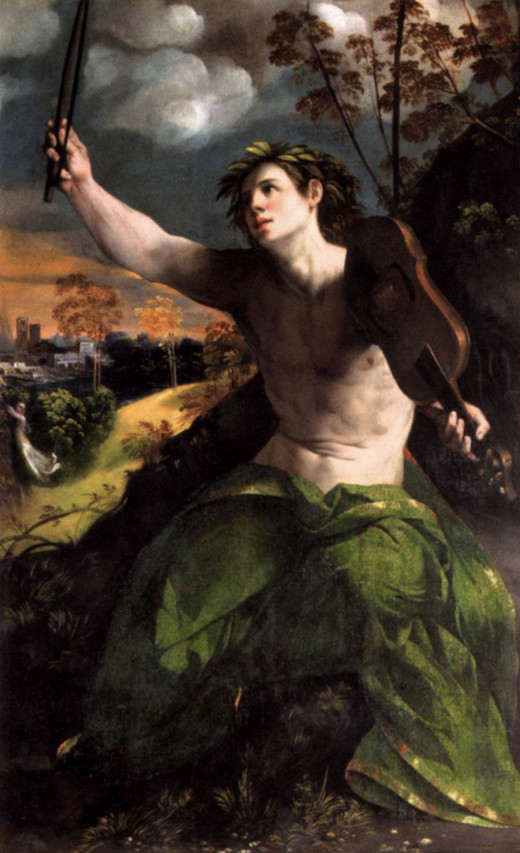
Apollo
The splendid Apollo, datable in the same period than Jupiter (1524), may allude to a similar theme. Apollo, god of music and poetry, is kidnapped by his music and nearly forgetful of the beloved nymph Daphne, that he is going to lose, depicted foreshortened on the background.
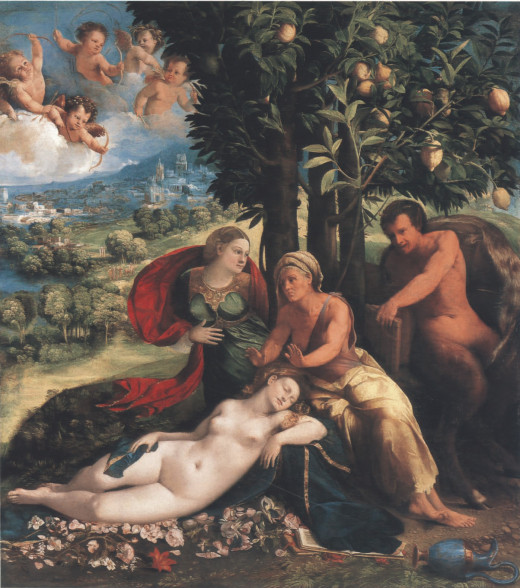
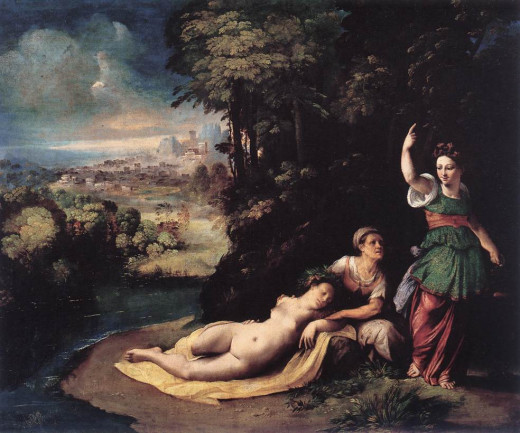
Allegories
The two allegories called Allegory with Pan and Mythological Allegory are generally considered to a representation of the same subject and are dated around 1530. However, the interpretation of the scene is not clear. In both paintings, a sleeping nude woman seems to be guarded by an old woman. In the first one, the presence of Pan leads to identify the naked woman with a nymph pursued by the god (probably Syrinx). In the second painting the nymph has sometimes been identified as Callisto (the canvas is also known as Diana and Callisto). The figure of the nude woman is a clear reference to Giorgione, as it is the landscape, which, especially in the second Allegory, recalls the Tempest. The gesture of the woman raising the index finger towards the sky in the Mythological Allegory is a citation from Leonardo.
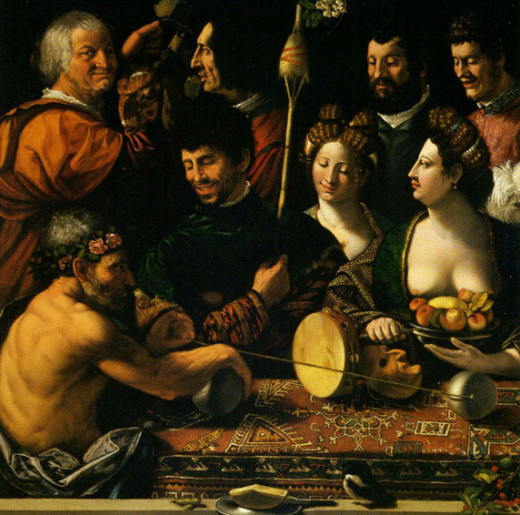
Allegory of Hercules (Witchcraft)
The interpretation of the Allegory of Hercules, also known as Witchcraft, is even more obscure. This is one of latest works by Dosso. The grotesque group of figures has been interpreted as the representation of the myth in which Hercules (the figure sitting at the table) is requested to choose between the evident Vice (the woman with the bowl of fruits and the uncovered breast) and the hidden Virtue (the more decent woman near her). Hercules is also the name of the Alfonso’s son, who succeeded to him after his death in 1534.
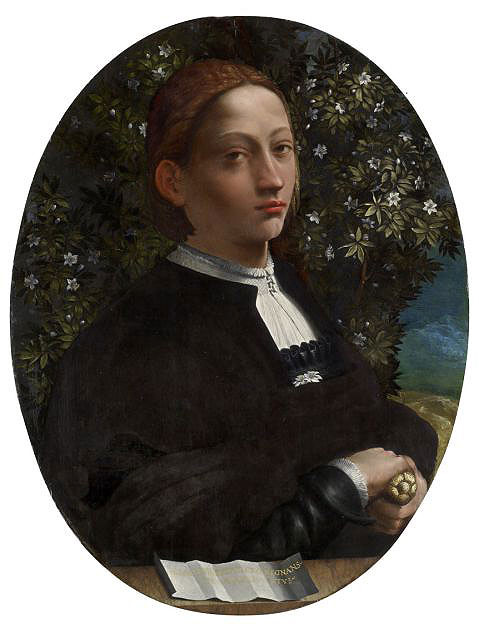
Lucrezia, the Dark Lady of Renaissance?
Lucrezia Borgia (Subiaco, 1480 – Ferrara, 1519) was the natural daughter of the Spanish cardinal Rodrigo Borgia, who became pope with the name of Alexander VI in 1492. She was at the centre of the ambitious goals of her father and her brother Caesar, pursued also by means of a wise policy of weddings. In this way, her figure has always been connected to the intrigues and murders committed by her family. She was married to Giovanni Sforza at the age of eleven, but after a few years her father obtained the cancellation of the marriage and arranged a new marriage with Alfonso of Aragon, that her brother Caesar made to kill two years later because a new change in the policy of alliances of the Borgia. In 1501 she married the duke Alfonso d’Este. He was initially reluctant to this marriage, but had to accept it for the pressure of the king of France Louis XII. As duchess of Ferrara, Lucrezia fostered the cultural life of the court and welcomed poets and humanists such as Ludovico Ariosto and Pietro Brembo. In the last years of her life, she put on the cilice and approached to the religion. The presumed portrait by Dosso might correspond to this period.
Mrs. Lucrezia Borgia, I Suppose
This painting was bought for a small amount by the Victoria National Gallery in Melbourne. It was thought to be the portrait of a young man, object of a scarce consideration until 2008, when the careful studies conducted by the researchers of the Gallery led to the unexpected conclusion that it might be the unique existent portrait of Lucrezia Borgia, the second wife of the duke Alfonso, painted by Dosso at the court of Ferrara. In fact, none of the other supposed portraits of Lucrezia is accepted by scholars with certainty. The main elements on which the hypothesis of the Australian researchers is based are the dagger held by the figure, the bush of myrtle on the background and the strict similarity with a bronze medal of Lucrezia Borgia, the only reliable representation of her face. The dagger is very unusual for a woman, but in this case it might be an allusion to her name, recalling the Roman Lucrezia, who stuck a dagger into her chest after been raped by the son of the king of Rome. The myrtle was the plant sacred to the goddess Venus and would indicate that the portrayed figure is a woman.


